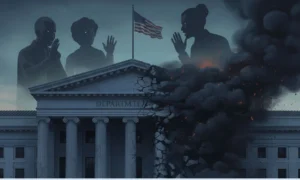
By Dilip Bobb
Recently, while delivering the Justice Sunanda Bhandare Memorial lecture, the chief justice of India admitted that the Supreme Court’s verdict in the Tukaram vs State of Maharashtra case—popularly known as the Mathura case—reflected a deeply regressive and patriarchal understanding of consent, effectively denying the social context of “power, coercion and vulnerability in which sexual violence often occurs.” Justice Gavai, who retires later this month, went on to call it “one of the most troubling moments in judicial history” where the legal system failed to protect the dignity of the very person it was meant to safeguard.”
The Mathura rape case refers to a landmark 1972 incident of custodial rape that sparked widespread public outrage in India and led to significant amendments in the nation’s rape laws. In March 1972, Mathura, a young orphaned tribal girl, was raped by two police constables, Tukaram and Ganpat, inside the Desaiganj police station in Maharashtra. She had been brought to the station during the night after her brother filed a complaint against her and her boyfriend, Ashok, who intended to marry her.
The case went through several judicial tiers. The Sessions Court which first dealt with the case, acquitted the accused policemen, stating that because no internal injuries were found and Mathura had an “old rupture” of her hymen (based on the unscientific “two-finger test”), she was “habituated to sexual intercourse” and had consented to the act. It is pertinent to note that, for the medical examination, Mathura was made to travel 140km to Chandrapur district headquarters. At the end of the four-hour journey, she was subjected to a two-finger test to determine her virginity.
Dr Kamal Shastrakar, who examined her almost 24 hours after the rape, recorded: “The girl had no injury on her person. Her hymen revealed old ruptures. The vagina admitted two fingers easily.”
The case then went to the Bombay High Court. The High Court reversed the acquittal, convicting the constables and sentencing them to imprisonment. It correctly held that passive submission due to fear in a police station setting could not be considered consent.
In September 1979, the Supreme Court overturned the High Court’s decision and acquitted the accused again. The apex court held that since Mathura did not raise an alarm and had no visible injury marks, the sexual intercourse was a “peaceful affair” and thus not rape.
The Supreme Court’s verdict caused national outrage, leading to widespread protests and the formation of women’s rights organizations across India. Four prominent law professors wrote an open letter to the then chief justice of India, criticizing the judgment and highlighting the judiciary’s patriarchal mindset and failure to understand power dynamics and consent in custodial settings.
The letter, which included internationally-known legal expert, Professor Upendra Baxi, stated that: “Your Lordship, this is an extraordinary decision sacrificing human rights of women under the law and the Constitution. The Court has provided no cogent analysis as to why the factors which weighed with the High Court were insufficient to justify conviction for rape. She was in the police station in the “dead hour of night”. The High Court found it impossible to believe that she might have taken initiative for intercourse. The fact remains that she was asked to remain in the police station even after her statement was recorded and her friends and relations were asked to leave. Why?… The Court says in its narration of facts, presumably based on the trial court records, that Tukaram was intoxicated. But this is not considered material either. Why? Why were the lights put off and doors shut? Your Lordship, does the Indian Supreme Court expect a young girl 14-16 years old, when trapped by two policemen inside the police station, to successfully raise alarm for help? Does it seriously expect the girl, a labourer, to put up such stiff resistance against well-built policemen so as to have substantial marks of physical injury? Does the absence of such marks necessarily imply absence of stiff resistance?… In any event, how could the fact of shouting within closed doors of a police station be established in such cases? In restoring the decision of the Sessions Judge, does the Supreme Court of India really believe that Mathura had “invented” the story of rape, and even the confinement in the police station, in order to sound “virtuous” before Ashok? Does the court believe that Mathura was so flirtatious that even when her brother, her employer and her lover were waiting outside the police station, she could not let go the opportunity of having ‘fun’ with two policemen and that too in the area adjoining a police station latrine? Does it believe with the Sessions Judge that Mathura was “habituated to sexual intercourse” to such an extent?” The letter concluded by saying: “You will no doubt forgive us for this impertinence of writing an open letter to you. But the future of judicial protection of human rights at grassroots level in India at the turn of the century, a concern we all share as citizens and as lawmen, leaves us with no other and better alternative.”
The case also sparked public protest for the first time about rape in India. In a historic ruling in 1979, the Supreme Court recognized the grave injustice and insensitivity done to Mathura. However, “technological problems” prevented it from overturning the acquittals.
The case, however, did lead to the reform of sexual assault laws. It gave rise to the women’s movement in India, sprouting a host of groups dedicated to empowering women. As the CNN reporter based in India wrote in an exhaustive report on the case: “At last, people here began to see gender-based violence for what it really is: a brutal act of power.”
Although Mathura did not receive justice through her case, the sustained activism forced the government to enact the Criminal Law (Amendment) Act, 1983. This amendment brought key changes to Indian law. These included:
- Custodial Rape: It introduced specific provisions making custodial rape a punishable offense.
- Burden of Proof: It shifted the burden of proof from the victim to the accused in cases where a woman states she did not consent, once intercourse is proven (Section 114A of the Indian Evidence Act).
- Victim Identity: It mandated in-camera trials and prohibited the disclosure of a victim’s identity in the media (Section 228A of the IPC).
The case is regarded as a turning point for the women’s movement in India, sparking a national dialogue on sexual violence and the need for a more sensitive and just legal system. A number of women’s group were formed as a direct response to the judgment, including the formation of the first feminist group in India against rape, Forum Against Rape (later renamed Forum Against Oppression of Women).
Despite that, in 1995 we had the other shocking case of sexual violence involving Bhanwari Devi in Rajasthan, Devi, an aging village woman was “punished” (read raped) by upper caste men for her efforts to stop child marriages in her district. After years of court hearings, the judge declared that the accused, being “upper caste men”, would not have raped a woman of a lower caste. Their acquittal in 1995 also caused widespread outrage, but also confirmed that cases of sexual violence against women were being handled by courts in what CJI Gavai referred to as “deeply regressive and patriarchal” manner.
The 2012 rape of a young girl in a bus in Delhi, known as the Nirbhaya case, also had the same impact as the Mathura case with national level demonstrations and massive public outrage, leading to the Justice JS Verma committee formed to suggest amendments to criminal laws. The committee made recommendations on a wide range of issues dealing with all kinds of sexual crimes and also made recommendations to the Sexual Harassment of Women at Workplace (Prevention, Prohibition and Redressal) Bill, 2012. In response to the Committee’s report, the Criminal Law Amendment Act, 2013, was enacted in February, 2013, which introduced comprehensive changes in the Indian Penal Code, 1860, Code of Criminal Procedure, 1973, and the Indian Evidence Act, 1872. Significantly, most women’s groups opposed the Verma Committee’s legislative outcomes, calling it inadequate.
Indeed, sexual crimes against women in India remains a deep-rooted and pervasive issue in an overtly patriarchal society. As Justice Gavai rightly pointed out: “Progress in gender justice can never be the achievement of courts alone. The dialogue between the courts and the people is a constant one, reminding us that the march towards gender equality is not a destination reached, but a commitment that needs to be constantly renewed.”
—The writer is former Senior Managing Editor, India Legal magazine
📰 Crime Today News is proudly sponsored by DRYFRUIT & CO – A Brand by eFabby Global LLC
Design & Developed by Yes Mom Hosting






